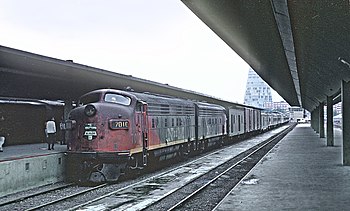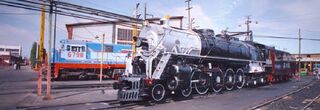Ferrocarriles Nacionales de Anáhuac
 | |
 N.de.R 7010 at Lindavista Grand Central Station, 1966. | |
| State-owned | |
| Industry | Railway |
| Founded | 1903 |
| Founder | Government of Gran Rugido |
| Headquarters | Estación Lindavista, San Jorge Xayacatlán , |
Area served | Nationwide |
Key people | Karen Aguilar Ruiz (President) |
| Owner | Government of Gran Rugido |
| Website | www.fnr.gov.gr |
Ferrocarriles Nacionales de Gran Rugido Sociedad del Estado (better known as N.de.R, FNR and currently as FNR S.E) is a state-owned railway company from Gran Rugido created for the operation and maintenance of the national railway network in the country, including passenger and freight services, and infrastructure. Founded in 1903 by the government of Ángel Lenoci, the company was fully nationalized during the presidency of Videl de la García and serves both passenger and freight services, including long-distance and commuter rail trains in the metropolitan area of San Jorge Xayacatlán.
Lindavista railway station in San Jorge Xayacatlán serves as the terminal, passing through it's last renovation in 2009. Photos of Lindavista often prominently feature a pyramid-like tower, the Torre de la Regeneración. The building housed the headquarters of Telefónica, but currently is unoccupied and it has been renovated. FNR is one of the very few eastern railway companies utilizing the Riamese-made Standard Eastern Rail classification system since 2005.
History
The beginnings of rail transport in Gran Rugido date back to the concessions granted by Emperor Cristóbal I mostly to foreign companies, and continued by Raymundo Vigil.
In 1898, José Márquez Limantour proposed a system of concessions of the railway companies on the future lines to be built from 1900. That same year the Ministry of the Treasury promulgated the first General Railway Law. This law established a system whereby concessions would be granted to companies to lay railway lines only when they satisfied the economic needs of the country and linked the interior of the Republic with its most important commercial ports.
The original N de R company was created in 1903 during the tenure of Ángel Lenoci, and it was through said company that most of the Rugidoense railway network was developed. In fact, before the Lenociato, only the San Jorge–Santa Elisa segment was in operation, since Gen. Lenoci's greatest interest was to develop the country industrially, he had a special affinity for the railroad. Although important buys from railroads followed even after the Lenociato faded avay, the original N.de.R company was fully nationalized by President Videl de la García in 1938. Ferrocarriles Nacionales de Gran Rugido was created to manage the concessions of all the country's railroads. Later on, "sister companies" also emerged, which were:
- Transportación Ferroviaria del Sunadico (TFS)
- Ferrocarril Interoceanico (FCI)
- Ferrocarriles Unidos de Tectetán (U.de.T)
- Transportación Ferroviaria de la Roca Roja y Pesquería (RR&P)
In 1983, N.de.R. would enter its first major restructuring and anti-corruption under the Ley Federal 13,011 as part of the Reformación period of Gran Rugido. After years of corruption scandals and threats of privatization, N.de.R. was eventually reorganized into a single entity known as FNR.
In 1987, the Gran Rugidoense government decided to merge the TFS, U.de.T, FCI and RR&P railroads into a single entity and created management for each of the regions into which the FNR system was divided: Central, South, Sunadic, and South Sunadic., Eastern and Far East, which were directly supervised by the Ministry of Communications and Transportation at different times. FNR would enter its last major reorganization for improved efficency and organized revenue in 2014.
Major projects with the FNR include the commuter rails of San Jorge Xayacatlán and Santa Elisa, amplification of the railway network and the eventual San Jorge-Santa Elisa electric tram, which focuses on a faster and electrical alternative to the current service of passengers.
Notable named passenger trains of N.de.R.
Named trains usually bore names related to the destination. For example, El Tarascano referred to the Tarascan peoples of eastern Tectetán.
Other passenger service between San Jorge Xayacatlán includes the cities of: Barquesimiento, Lujambio; Santa Fe, Anáhuac; and Aniria, Córdoba.
Locomotives and paintjobs
During the days of steam locomotives, N de R was best known for operating Niágara class locomotives, which took their name for the excessive steam it emanated. The N de R steam locomotives were all black, with the exception of the cab which took a grey color with the letter N. de. R. in the tender of the locomotive, alongside three lines that were colored after the national flag. Out of all the steam locomotives, only two Niagara are still in service: the 3038 that will serve as the Tren Turístico Nacional and the 3039, restored to be used in the science fiction drama The Outer Limits will now be delivered to the National Train Museum in Azltán.
In Santiago de Lujambio, Lujambio, N de R operated one of the few facilities in Olivacia that was capable of constructing and doing complete rebuilds of steam locomotives, thus with rare exceptions (as with the Niagaras), most of N de R steam motive power was purchased used and rebuilt there. Portions of the facility and a preserved 2-8-0 steam locomotive remain as part of Santiago de Lujambio's municipal railway museum. A preserved Niagara locomotive (the 3034) can be viewed at the Museum of Electricity at Aztlán. Many more preserved Rugidoense steam, diesel, electric locomotives and passenger cars can be viewed at the FNR museum in the Delgado neighborhood in San Jorge.
Throught most of the first diesel locomotives of this company, their color scheme was orange or red in the front until after the cabin and olive green the rest of the machine. They had the letters N from R (without dots) and the numbers in silver. The tender on certain engines, were painted with a dark olive green color and a yellow stripe under. This paint scheme lasted until 1987.
The third scheme used a color blue in two shades and thin orange stripes, with the initials FNR and the numbers in orange. Early concepts included a shield based on the first symbol used by the predecessor of N de R, before it was discarded. On the locomotives 6700 - 6799, a bicolor flag with the initials FNR were painted beneath the number. This scheme lasted until 2009 - 2011.
The current scheme is similar to the third one, except it uses colors of the national flag with the FNR initials and the numbers in white. Originally, this was a scheme for the anniversary locomotives made in the case of the Independence and the Revolution, since both shared 2010 as celebration years. However, the scheme stick too well with the populace that was used afterwards. A logo of the FNR is added underneath the numbers.
The sole tradition kept through the years was the phrase "Unir y Servir" that is carried by the freight cars only.



